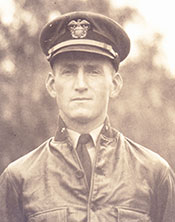SCRAPBOOKS
BACKGROUND Emile Choureé was a U.S. Navy pilot born in 1894. He was designated Naval Aviator #1591 in 1918 and married Catherine Davis in 1920. He was a career Navy officer, achieving the rank of Lieutenant Commander. He participated with Navy teams at the National Air Races where he served as the announcer at Naval aerobatic performances. He also flew support aircraft for the team, carrying mechanics and other support personnel, as well as tools and spares. He died in an air crash at Scott Field, East St. Louis, IL in January, 1938. He had two children. They and his wife survived him. A ship, the U.S.S. Choureé (ARV-1), posthumously was named after him. It was launched about a year before the end of WWII, on May 22, 1944, about six years after his passing. He collected and left behind a significant number of photographs, documents and memorabilia related to his naval career and personal life. These items are exhibited in the DOCUMENTS, OBJECTS, PHOTOGRAPHS, PILOT LOG BOOKS and SCRAPBOOKS sections of his Collection.
THE SCRAPBOOKS
There are seven photo scrapbooks. They are assembled on black or beige pulp paper with glue (not corner tabs) attaching the photos. Some of the images are hand-labeled using white or black ink, which was typical of the era. The pages are two-hole punched and tied together with shoelace-like string, with aglets.
Two of Choureé's scrapbooks detail with photographs his early Navy assignments. They both focus on Key West, Miami and Pensacola, FL, and on his assignment at Coco Solo, Canal Zone (C.Z.). The remaining five albums document in photographs, memorabilia and news clippings, the 1929, 1930, 1931, 1933 and 1934 National Air Races (NAR). Note the absence of 1932.
The great majority of photographs in his books are candid snapshots taken by Choureé and his friends. These are interspersed with only a few "official" images taken by the government (e.g. PDF page 32 of scrapbook one), or commercially available as postcards (e.g. PDF pages 4-6 of his first scrapbook).
Curiously, given Choureé's general tendency toward neatness, the photos in both his assignment scrapbooks do not appear to be in any particular order, which could mean a couple of things. He assembled his albums without making an effort to organize them chronologically or geographically, or someone took the string-bound albums apart over the years and failed to put them back together in the correct order. This might be the case, because the first image on his PHOTOGRAPHS page is a loose leaf from one of his albums. No such problem for the NAR books. Although not chronological, they do each document only one year.
Regardless, there are interesting connections between his scrapbooks and the information found in his pilot log books, linked separately, above. Although I do make a few connections below, in the interest of making these materials available to site visitors in a timely manner, I have not exhaustively explored and documented all the connections. If you take the time to correlate his flight log records with some of the aircraft numbers and/or places and people visible in the photographs, please let me KNOW your findings.
I exhibit below 35 pages illustrating various aspects of his scrapbooks. But I made no effort to exhibit each and every page. You may download each scrapbook as a PDF file and scroll through them. All the images posted below came from his scrapbooks or his flight logs. I defined each one in the text with a description of where it came from (PDF page #), and if there are pilot log cross-references, I provide the location in the pilot log, too (PDF page #). So download each book in order, and follow along with the texts I present below.
ASSIGNMENT SCRAPBOOK ONE (PDF 44Mb):
Choureé traveled to Key West, FL during July, 1918 to begin his first practical flight training. Indeed, according to his flight log book number one (cf. PDF page 3 of log one at the link above), his first flight was on July 24, 1918. He made his first solo flight on July 30th after about nine hours of instruction. He appears to have had an early aptitude for flight. Some of the images in this scrapbook are of aircraft similar to the ones he logged in his pilot record.
Curtiss N-9, A-2507, Pensacola, FL, 1918
 |
He moved on to Miami in August, 1918, and to Pensacola in September. One aircraft, a type he flew frequently, is the Curtiss N-9, a single-engine biplane on floats pictured at left. A-2507 was known to be flown by Choureé. Indeed, on November 9, 1918 it is logged in his flight log number one on PDF page 17.
Another type flown by Choureé, the Curtiss H-16, photographed at Pensacola, is below right. It displays Bureau Number A-3479. This airplane appears in none of Choureé's pilot log entries. He probably photographed it, and many other aircraft and locations, from the cockpit of his airplane. A-3479 appears on PDF page 51 of this scrapbook.
Naval Aircraft Factory (Curtiss) H-16, Scrapbook Page 51
 |
The Panama photos in this album feature typical aircraft of the era, and the people who flew them. Officers, enlisted men, and their civilian friends are shown at work as well as at leisure. Some shots are on shipboard during Choureé's transshipment to assignments. According to a passenger list found at ancestry.com, Choureé arrived back at New York from Cristobal, C.Z. aboard the S.S. Allianca on May 31, 1919. Photographs taken during this voyage can be found on page 28 of this scrapbook.
As examples of the disorder in his scrapbooks mentioned above, a photo taken during his trip TO the Canal Zone, February-March, 1918, appears on PDF page 36 of this same album. As well, on page 40 an aerial view of the Naval Air Station at San Diego is displayed next to images of San Blas Indians in Panama.
---o0o---
ASSIGNMENT SCRAPBOOK TWO (PDF 17Mb):
This book contains photographs of his assignment in Panama, C.Z. At the time, early in his naval career, Choureé was based at the Naval Air Station, Coco Solo.
An excellent example of the correlation between his photo albums and his pilot log books is below. A photograph of the Canal Zone's first Curtiss F-5-L appears on PDF page 3 of his Panama photo album. This was a large, twin-engine biplane flying boat. It was fitted with Liberty engines and built under Curtiss license from the British Felixstowe company. It became the Navy's standard patrol flying boat through 1928. Curtiss built 60 of them. As testimony to the disorganization of his scrapbooks, two additional photographs of this airplane can be found on PDF pages 45-47. They show before and after photographs of the airplane as it was uncrated and then assembled.
The First Curtiss F-5-L at Coco Solo, C.Z., April 8, 1920
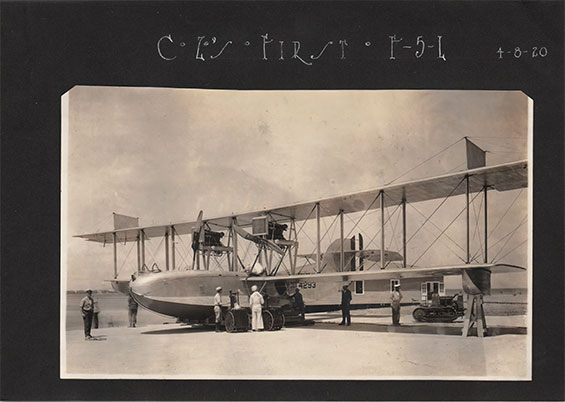 |
Choureé flew the airplane pictured, on the date cited, as evidenced in his pilot log book number one, PDF page 34, below. He judged the airplane "OK," and flew it on a short cross-country mission to Porto Bello, followed by a brief "inside" flight on the 10th. "Inside" probably meant over Manzanillo Bay and not out over the Atlantic Ocean. He flew it a few times later in April, one flight cited as meeting General Pershing. Does anyone KNOW what "SS. N. Pac" means?
Chouree's Documented Flights in the First Curtiss F-5-L at Coco Solo, C.Z., April 8, 10, 24, 1920
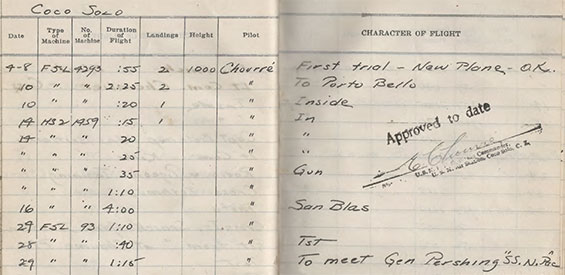 |
He flew A-4293 a couple of times in May as well. If you download and compare his pilot log number one, you'll find that he tested another new F-5-L, A-4295, in May and A-4294 in June.
His scrapbook continues with many candid photographs of Panama (aerial views, canal locks, ships in harbor, views of friends), which are not in any logical order. His last flight at Coco Solo was on August 23, 1920, when he was transferred to the Pacific Fleet and based at San Diego. There are no photographs of San Diego in this album.
---o0o---
NATIONAL AIR RACES, 1929 (PDF 44Mb):
The 1929 National Air Races (NAR) were held at Cleveland, OH from August August 4th to September 2nd. The details of Choureé's participation in the NAR are outlined at his biography page, linked above.
Although we do not have Choureé's pilot log book for 1929 and most of 1930, because of the entries in the Davis-Monthan Register, we know with whom he was flying (about 20 other Navy pilots and non-flight personnel), and the identification number of his airplane, the Sikorsky XPS-2, A-8090.
We also know approximately what his flight itinerary was by following along with the news articles and photographs of this scrapbook. You may download the full scrapbook at the link above. News articles from El Paso and Dallas, TX, Kansas City, MO and Cleveland, OH nicely documented their route and provided a snapshot of their lives on the ground at these and other waypoints. As well, Choureé's own sketch of the route of flight taken by his Navy entourage was pasted inside the cover of this scrapbook, below. The zig-zag in Missouri on the return trip was due to bad weather (see below).
San Diego to Cleveland Route Map, August, 1929
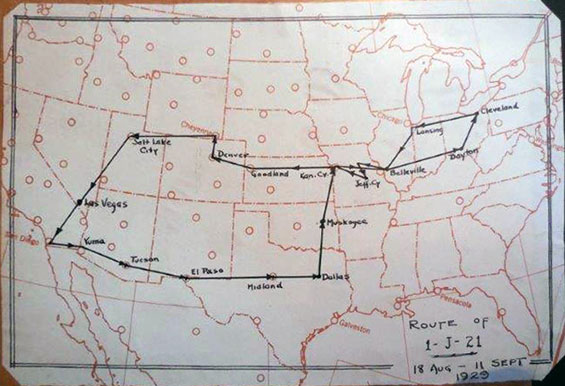 |
Charles Lindbergh Flight Notes, August, 1929
 |
The activities of the Navy group at Cleveland were also documented in the scrapbook, including the kinds of performances offered by Navy pilots and others.
A stunning artifact found on PDF page 18 of this scrapbook is a penciled note in Charles Lindbergh's own handwriting that lists the maneuvers he performed as he flew with a Navy section of three planes. This artifact is shown at left as annotated by Choureé.
According to news articles inserted in the scrapbook near this artifact, Lindbergh flew with Lts. Frank O'Bierne and F.N. Kivette. A news photograph of the three is on PDF page 20, and a description of their act is in a news article pasted on page 25, dated August 27, 1929.
One spectacular exhibition performed by the Navy was formation flights while the participating aircraft were attached at their wingtips by manila ropes just 35 feet long. An article describing the preparation and excution of one such flight is on PDF page 27. And an excellent air-to-air photograph of tethered flight is on page 41. The article states that upwards of 125,000 people watched that exhibition. It was estimated to be the largest crowd ever assembled in Cleveland's history.
The Navy, and the Army as well, was very much interested in giving the public a good idea of what aviation meant to the military; they wanted the public to have a good impression of the flying skills of its pilots. The news articles bear witness to this. While on their cross-country flight legs, the Navy fliers also performed at various state fairs in the areas through which they flew. Refer to the undated and unsourced article on the right side of PDF page 28. Likewise, later as the group made its way back to San Diego, they stopped in the major towns along the way to give exhibitions (see Denver on PDF page 44).
Also on page 28 is an article about a separate incident the involved Register pilot Lady Mary Heath. Although this article suggests she was not expected to survive her crash of her Great Lakes trainer through a factory roof, she did survive, only to die a decade or so later from an unfortunate fall down the steps of a double-decker bus.
Elsewhere, on PDF page 29, a news article announced that for the first time that a Ford trimotor transport was flown inverted and performed seven consecutive loops. Parks Airport Register signer C.W. "Speed" Holman was the pilot.
Also reported, clipped and duly pasted in the scrapbook (PDF page 30 ff.) was an article describing the arrival of the rigid airship Los Angeles. As a demonstration, a Navy officer was transferred to the passenger compartment of an airplane hooked to the bottom of the Los Angeles, and flown to the ground. This was the first time such a feat had been accomplished. The pilot was Navy Lt. A.W. Gorton. Also on board the Los Angeles was Clover Field Register signer Senator Hiram Bingham. Choureé would have his chance to hook onto an airship, the U.S.S. Macon, in February, 1934. Please follow the link to see him doing it.
Relevant to Choureé's role for the Navy at the NAR, PDF page 33 shows him posed with his Sikorsky and his crew, who provided maintenance and logistical support for the Navy team. On the same page is Lt. Choureé "behind the mike." He was also the announcer who described to the public what the Navy performance teams were doing. Another snapshot of him announcing, below, center, is on PDF page 40.
Choureé Announcing Navy Performance Events, 1929 National Air Races
 |
At the bottom of this image is Choureé's annotation in ink. The dots on the album paper are dry glue. To attach a photograph or piece of paper to the original scrapbook page, one would moisten the adhesive dots and adhere the object. As these pages age, however, they develop a washboard folding of the paper, which tends to lift the adhered objects off the paper. The old glue is usually crystalized and unuseable. This method of scrapbooking would not be considered archival.
After the NAR, the return to San Diego was difficult, because of bad weather. Some craft were delayed and/or scattered. But, no mishaps occurred and most of the obligations for exhibitions by the group were met. The rest of this scrapbook shows articles and photographs related to their return from Cleveland.
Additional information about the 1929 National Air Races is at the link. Notably, the NAR for 1929 was the first time women were allowed to compete in that major U.S. air race. A photograph of the twenty female competitors and a route map are exhibited about half way down the page at the link. A number of books have either been specifically written, or refer to, the women's race.
---o0o---
NATIONAL AIR RACES, 1930 (PDF 47Mb):
The 1930 NAR were held at Chicago, IL Curtiss-Reynolds Airport, August 23rd to September 1st. Choureé's participation is captured in this scrapbook, and his travel to Chicago is evidenced by his signature in the Davis-Monthan Register on Monday, August 18, 1930 at noon. He carried as copilot J.M. Frosio. They were flying a Sikorsky identifiable in a photograph in this scrapbook as A-8285, a Sikorsky PS-3. They carried five passengers identified as Piper, Houser, Born, Gabriel and Stepp. They were eastbound to Chicago. They had allowed five days to make it to Chicago.
Sikorsky PS-3, A-8285
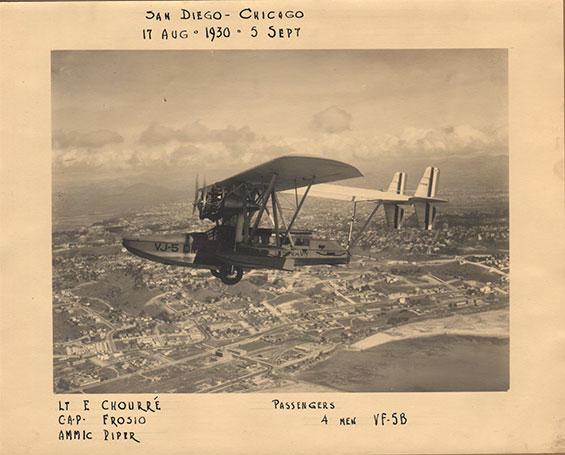 |
Above is a photograph of A-8285 from PDF page 5 of this scrapbook. Again, as in 1929, Choureé drew a route chart for his cross-country journey, below, PDF page 3, below.
Emile Choureé's 1930 Cross-Country Course, San Diego to Chicago & Return
 |
Missing from the Davis-Monthan Register was the list of other Navy pilots participating in the 1930 NAR (the previous year there were 20 or so listed as flying through on their way to the 1929 Races). However, PDF pages 4 and 8 provide the official Navy list of participants, including Choureé. None on the list are signed in the Register.
Undated & Unsourced San Diego News Article
 |
Despite the absence of information in the Register, we can follow Choureé part of the way on his voyage with the news clippings he included in his scrapbook. At left is an undated and unsourced news article (PDF page 8) that announces the squadron's departure from San Diego.
Choureé Landing, Midland, TX, August 19, 1930
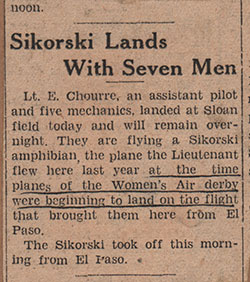 |
Likewise, at right, is an article clipped from the Midland, TX newspaper on August 19, 1930. It reports Choureé's landing in his Sikorski (sic).
Elsewhere in the August 19 article, their itinerary was summarized as follows, "The squadron left San Diego on the morning of August 18, refueled at Tucson, stopped at El Paso for the night and took off for Midland at 8 o'clock. The planes refueled here and announced Dallas as an overnight stop. Kansas City will be the overnight stop Wednesday."
At Dallas the following day, the news headlined "Flyers Thrill Dallas Crowd with Bravado." According to the article, they landed at 4:45PM. The "thrill" was simply the formation maneuvers the pilots made as they approached for their landings. No aerobatics were performed. The crowd that formed was easily amused. That crowd included Chamber of Commerce members, as well as Register pilot Lt. Harry Weddington, U.S. Army executive officer at Hensley Field, where the Dallas landings were made.
The next scrapbooked article is from Moline, IL (PDF page 13, dated August 21), where the crowd, estimated as "thousands," watched as the squadron passed over the field seventeen abreast before their landing. As part of the festivities, Register pilot Stub Quinby performed an aerobatics display in a Monocoupe aircraft.
Scrapbook pages 18 through 52 exhibit various articles and photos from the NAR. On PDF page 27 is a group photograph of the Navy squadron that took part in the 1930 NAR.
One important event was the dedication of the Lindbergh Beacon, which shone from the top of the Palmolive Building for the first time during the NAR. The event was captured in the news photo, below, from PDF page 25. The Palmolive Building eventually became the Playboy Building.
Lindbergh Beacon, Palmolive Building, Chicago, IL
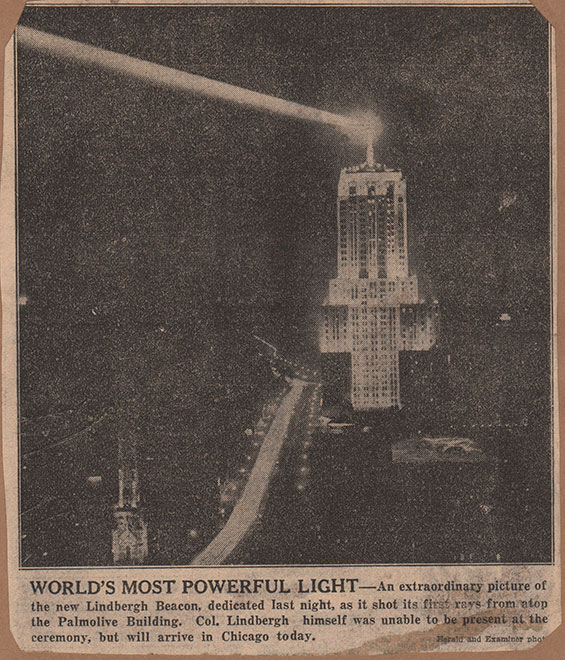 |
On the same page was one of the few mentions of the female pilots who competed in the 1930 NAR for only the second time. Register pilot Gladys O'Donnell, below, won the Women's Derby, which was flown from Long Beach, CA to Chicago that year. As was typical of the day, other articles about the women discussed their wardrobe or card playing, not their considerable flying skills.
Gladys O'Donnell, August, 1930, Chicago, IL
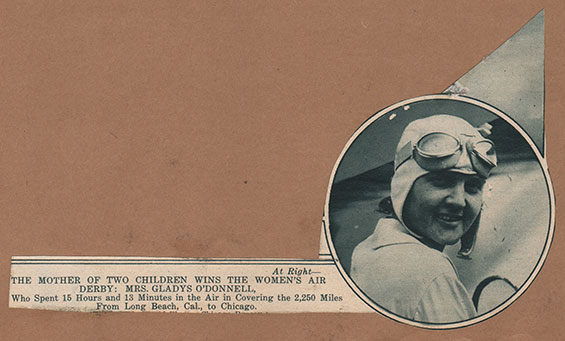 |
Undated & Unsourced Article Summarizing Return of Navy Planes
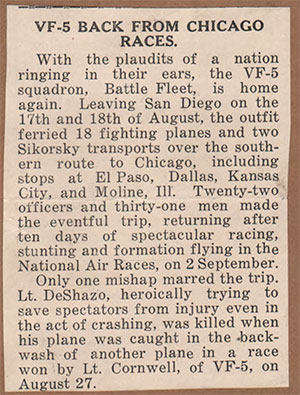 |
An unfortunate crash took the life of one of the Navy flyers. Lt. J.P. DeShazo was killed when his airplane burst into flame and dove into the ground near the bleachers, killing a concessionaire and injuring eleven spectators. His was one of three deaths during the 1930 NAR, and the only Navy flyer.
Scrapbook PDF page 53, left, presents the first article related to the return flight to San Diego of Navy participants. Twenty-two officers, 31 men and 20 airplanes made the trip.
Undated & Unsourced Article Summarizing Return of Navy Planes
 |
The Navy competed in only one race, event #31, the U.S. Navy 10-lap race on a 5-mile course. It is mentioned at the bottom of the article, left. In the 1931 Aircraft Yearbook (which reported on the 1930 NAR) DeShazo is listed as the 3rd place winner of the event, since he crashed after the race ended.
The article, right estimates crowd sizes and places DeShazo as one of the three stunt pilots. The Navy flew performances eight days and two nights of their 10-day stay at the NAR.
Navy participation at the NAR was much appreciated, at the end of this scrapbook was a sheaf of letters sent to Choureé thanking him for that participation. He called these letters "The Apple Sauce," and labeled them as such, below. The bronze commemorative medal was not found among the items in his footlockers.
Thank You Letter, September 16, 1930
 |
Another token of appreciation is the photograph, below, found on PDF page 55. A similar photograph was found among his PHOTOGRAPHS page at the link. Note the differences in the annotations and in the positions of the people. Choureé had participated in the two previous NAR.
Souvenir Photograph From the 1930 National Air Races
 |
Finally, 1930 marked the tenth NAR. It was commemorated with handsome art deco posters and artwork, as below from PDF page 2.
Tenth Anniversary NAR Art Work
 |
Below is the cover from the official NAR visitor directory (25-cents). To give you an idea of what these programs were like, the full program for the 1936 NAR is downloadable in PDF form (8 Mb) from the DOCUMENTS section of this COLLECTION.
Tenth Anniversary NAR Visitor Directory
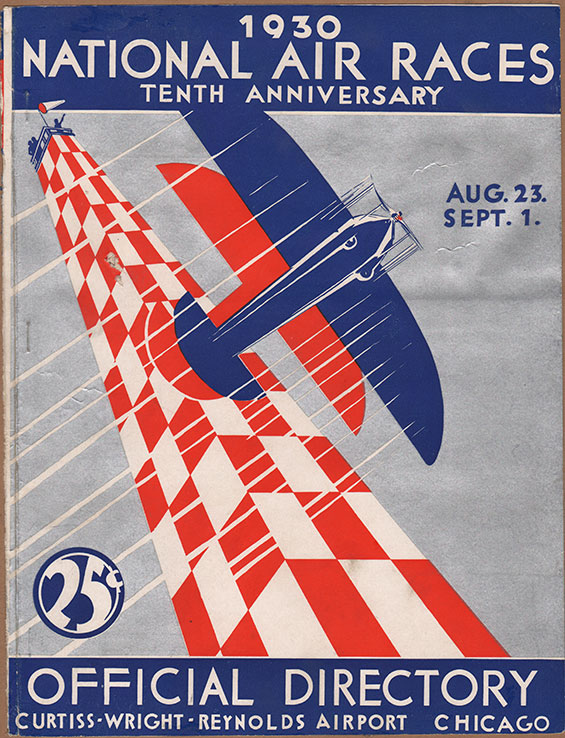 |
Additional information about the 1930 National Air Races is at the link. A video showing a brief Navy formation at the the 1930 NAR is at the link.
---o0o---
NATIONAL AIR RACES, 1931 (PDF 69 Mb):
The 1931 NAR were held at Cleveland again, from August 29th to September 7th. You may download Choureé's entire scrapbook commemorating the event at the link above. The specific order that directed Choureé to the NAR is below. It outlined his duties and who was responsible to pay his expenses. It did not specify a method of travel. This letter appears on PDF page 84 in this scrapbook.
Emile Choureé's Orders for the 1931 NAR, August 13, 1931
 |
The artwork for program covers and posters remained stunning and colorful in 1931. The program cover is below from PDF page 3.
Program Cover, 1931 NAR
 |
Notice Choureé's label for the cover below where it was pasted in the scrapbook. Note, too, the artist, Charles Hubbell.
There was nothing noted in Choureé's pilot log book during the NAR dates that suggest he flew to Cleveland. Indeed, there is a hiatus in his flight log from August 4th to September 17th. We know Choureé was at the NAR, because he is quoted in several news articles that are preserved in his scrapbook. The absence of flight time could simply mean that he took the train, or flew with someone else to Cleveland. Regardless, PDF pages 9 and 10 exhibit news photographs of the Navy pilots who were sent to the NAR. None of them signed the Davis-Monthan Register, because they (fighting squadron #3) flew to Cleveland from their base in Norfolk, VA (U.S.S. Langley).
Emile Choureé, Cleveland A.C. Pass, August-September, 1931
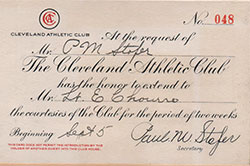 |
In all, 36 pilots represented the Navy, as cited in a news article in Choureé's scrapbook. And, "Lieut. Emile Choureé is here from San Diego to do the radio and public address announcing for navy maneuvers at the races." As a VIP, Choureé was afforded some perks, such as the pass for the Cleveland Athletic Club, left. Not to look a gift horse in the mouth, but the NAR ended on September 7th.
ChoureéAnother invitation to the official Aviation Ball appears below, right. Its joint sponsorship by the powers-that-be probably made this a choice affair. This invitation was partially attached to the scrapbook by a NAR sticker that I left intact in the upper left corner. Choureé decorated his scrapbook in numerous places with these stickers.
Emile Choureé, Aviation Ball Invitation, September 5, 1931
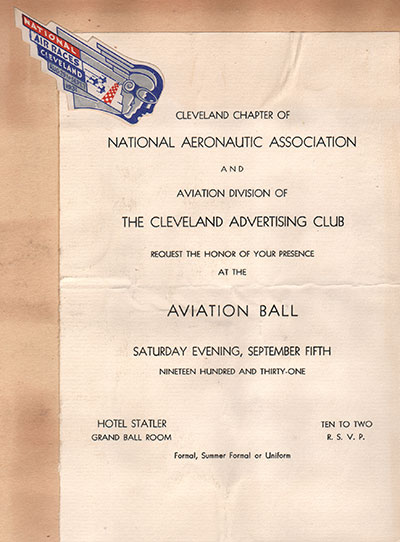 |
The rigid airship U.S.S. Akron was to make a maiden voyage to Cleveland, but testing problems delayed its first flight to after the NAR were closed. There were 104 Navy officers and enlisted men. A new articles on PDF pages 24 and 31 quote some of Choureé's comments as an announcer during a mid-air crash of two Marine Corps airplanes.
Another article cited a total of 286 individual aircraft landing at the Cleveland Airport in one day. This represented the highest number of aircraft per day since the airport opened eight years earlier. This contrasts with a statement that, under normal circumstances, "...there are 54 scheduled arrivals and departures of passenger planes from the Cleveland Airport every day." The volume of air traffic is suggested in the nice rotogravure view of the air race grounds exhibited on PDF page 44.
Yet all was not well at the Races. The attendance was down versus the attendance in 1929 and 1930. Given the 125,000 people watched the Navy pilots perform their rope tether exhibition in 1929, the NAR committee in 1931 was concerned that their costs would not be met due to, "...business depression and high admission prices...." Barely two years into the Great Depression, the $1.00 daily admission price was too high for many people (parking was free!), and the Akron didn't make it, which would have boosted attendance. The article below, left summarizes the concern.
Undated News Clip, NAR 1931
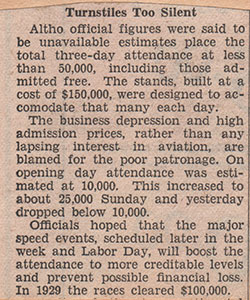 |
Along with low attendance, a delay in the proceedings caused by the arrival of the cross-country, Los Angeles to Cleveland Handicap Derby, caused some unrest among patrons and organizers alike. And a rain storm all day Wednesday caused many people to abandon the venue after paper rain coats sold out. The events were finally cancelled for the day. Some complained that the races lasted ten days, which they thought was too long. Separate from the civil disappointments, the crashes of three Marine Corps airplanes and one Army plane, set the U.S. behind an estimated $125,000.
Things looked up through Labor Day, however, and the 1931 NAR ended with an estimated gate of 370,000 over ten days, with the final day attendance estimated at 75,000. At the close of events, Cleveland was chosen to be the venue for the 1932 NAR.
A big deal in 1931 was Jimmy Doolittle's win of the Bendix cross-country race (see PDF pages 69ff.) from Burbank, CA to Cleveland. According to the Aircraft Yearbook for 1932, Doolittle flew from Los Angeles to Cleveland in 9 hours, 10 minutes and 21 seconds to win at an average speed of 223.038 miles per hour. He flew a Laird aircraft, named the "Laird Super Solution," a small purpose-built biplane with a 510HP motor.
For winning the Bendix, Doolittle collected a purse of $5,000. At Cleveland he refuelled and went on to Newark to break the transcontinental speed record with a total time of 11 hours, 16 minutes and 10 seconds. He earned an additional $2,500 for the cross-country record for the total of $7,500 cited in the Aircraft Yearbook. His trip constituted the fastest time any human had ever traveled across the country. You will see some discrepancies over timing and prize money between the Aircraft Yearbook figures and the news articles in Choureé's scrapbook.
Curiously, the Aircraft Yearbook for 1932, which reported on the 1931 NAR, did not include results for competitions by Navy flyers, or for any other branch of the services except a National Guard race for the Douglas Trophy. Rather, the Yearbook printed a blanket statement about Event #37, "Army, Navy and Marines -- Scheduled as Respective Services Desired."
Racing or not, the Navy team who attended the 1931 NAR is pictured and identified on PDF page 77 in Choureé's scrapbook, shown below. They were based on the U.S.S. Langley at Norfolk, VA. A brief video showing Navy planes attached at their wingtips by ropes is at the link.
Navy Performance Team, 1931 National Air Races, Cleveland, OH
 |
Another autographed photograph of the assigned announcers at the NAR is below (PDF page 82). This is a different set of announcers than in the 1930 NAR portrait, above.
Military and Civilian Air Show Announcers, Cleveland, OH, 1931 National Air Races
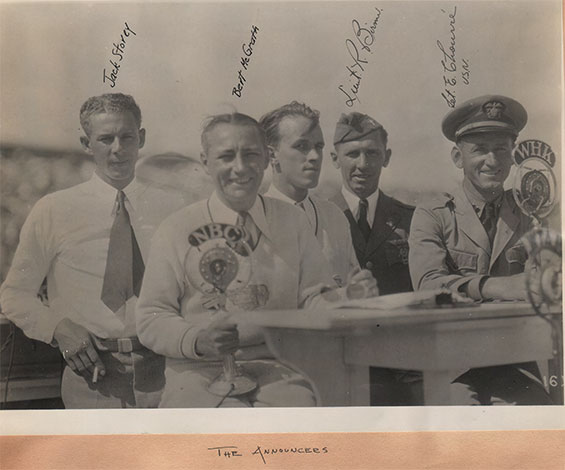 |
Register pilot Roland Birnn, second from right, was involved with Army Air Corps public relations and landed at Tucson just a few months before this photograph was taken.
---o0o---
The 1932 National Air Races were held at Cleveland from August 27th to September 5th. Unfortunately, Choureé left no record of it in the form of a scrapbook or photographs. I do not know if he attended the event. If you have information, please let me KNOW. Note the 10-day period of the races, despite the criticism in 1931 that they lasted too long.
---o0o---
NATIONAL AIR RACES, 1933 (PDF 29 Mb):
The 1933 NAR were held at Los Angeles, CA, July 1-4, 1933. You may download Choureé's entire scrapbook commemorating the event at the link above. The Los Angeles Municipal Airport was otherwise known as Mines Field. The races this year only lasted four days, a considerable abridgement from earlier years.
Logo, National Air Races, July, 1933
 |
At left is the official logo for the 1933 event (PDF page 2). The Los Angeles Municipal Airport was otherwise known as Mines Field.
No report on the results of military events appeared in the Aircraft Yearbook for 1934, which reported on the 1933 event. In fact, given the abbreviated timeline, the entire NAR report only spanned six pages in the Yearbook. The Great Depression was at fault.
NYT, Ca. Monday, July 3, 1933
 |
Nevertheless, according to news clippings in the scrapbook, Army and Marine Corps flyers enhanced the proceedings, performing every day (PDF pages 4-6). And times weren't so hard that Will Rogers didn't have something amusing to say to The New York TImes (ca. Monday, July 3rd), right (PDF page 6). According to one article, attendance reached 50,000 on Monday.
A Who's Who of Register pilots are mentioned in various articles you'll find in this scrapbook. For example, Ruth Nichols, Roscoe Turner (won the 1933 Bendix Race), May Haizlip, Henrietta Sumner, Martie Bowman, Gladys O'Donnell (winners of the Aerol Trophy Women's Race), Amelia Earhart, Lee Gehlbach, Steve Wittman and Ira Eaker are just a few. Take a few minutes to follow the links and read about these pilots for a better understanding of the depth of talent found in the Davis-Monthan and other Registers.
Besides Will Rogers, other Hollywood-types attended the NAR. One in particular, cowboy actor Hoot Gibson, was an aviator. He entered an air race with rival cowboy star Ken Maynard, also an aviator. Gibson crashed his airplane and was seriously injured. The report of the accident and its aftermath appear on PDF pages 21-22. Gibson owned Register airplane NC730K, a Butler Black Hawk.
As with the 1931 NAR, above, Choureé was given orders on very short notice to attend and work at the 1933 NAR. His orders appear below, dated June 30th, only one day before the races began (PDF page 31). His commute was short, however, being only from San Diego to Los Angeles that year.
Choureé's Orders to Attend the 1933 NAR, June 30, 1933
 |
And the "applesauce" was included at the end of his scrapbook. What is significant about this warm thank you letter is that it is signed by fellow Register pilot Dudley Steele, then Chairman of the Army & Navy Liaison Committee for the NAR (PDF page 32).
Thank You Letter From Dudley M. Steele, July 13, 1933
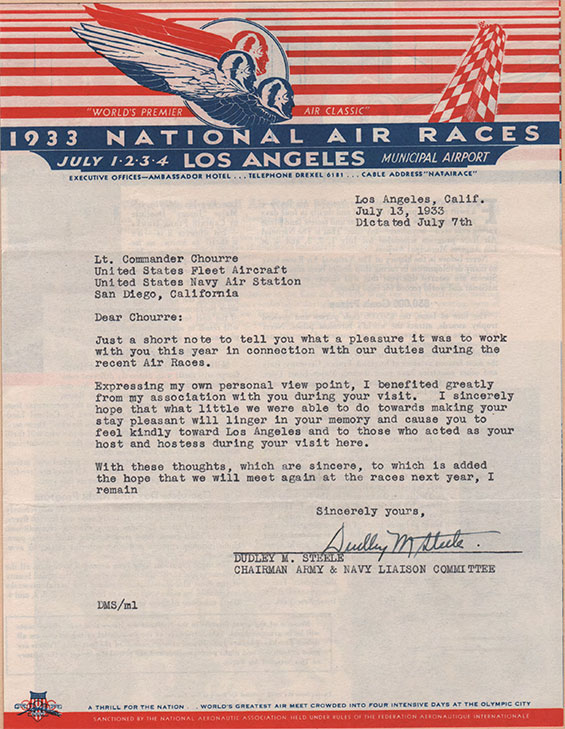 |
---o0o---
NATIONAL AIR RACES, 1934 (PDF 44Mb):
The 1934 National Air Races were again held in Cleveland, OH, August 31st to September 3rd. Like the 1933 Races, they were abbreviated to only four days. Choureé documented the people and the event fairly well in this scrapbook.
The cover of the visitor program is below (PDF page 3). Although still exhibiting an Art Deco flavor, it is not quite so ornate or exciting as in previous years. Given that the Wright Brothers' first flight was in December, 1903, I don't know why, in 1934, the NAR commemorated just 25 years of aviation progress. That should have been done at the NAR for 1928 or 29.
Program Cover, 1934 NAR
 |
Uniquely, in this scrapbook, Choureé included a portrait of the commander of the Navy contingent, VF-6B, which came to Cleveland again from Norfolk, VA. The commander was Register pilot Ralph A. Ofstie, who landed once at Tucson, Sunday, October 10, 1926. Below, is the portrait as it appeared in Choureé's scrapbook.
Register Pilot R.A. Ofstie, Commanding VF-6B Squadron
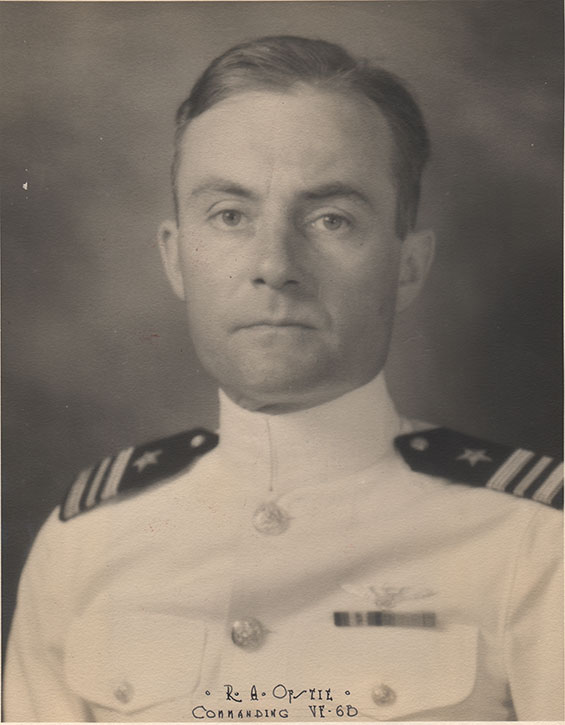 |
Also included were Ofstie's orders to attend the NAR, below.
Orders, Register Pilot R.A. Ofstie, Commanding VF-6B
Squadron
 |
Ofstie's command consisted of the nineteen people (including himself) posed and cited in the photograph below. Ofstie stands below the propeller hub.
Navy Personnel in VF-6B Squadron, 1934 NAR
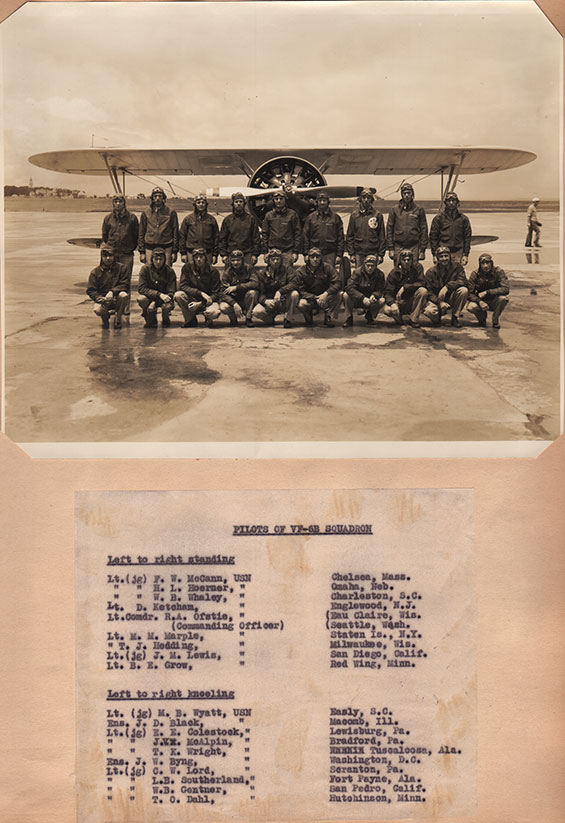 |
None of these pilots are signers of the Davis-Monthan Register. A news article ca. August 30th described the departure of the nineteen from Anacostia (PDF page 8).
An informative, three-fold pamphlet was included inserted in this scrapbook (not glued to it). I was able to remove and scan it separately. It was large, stretching to 17" when unfolded, and 4" high. It barely fit diagonally on my scanner bed (that's why some of the corners are missing). I stitched the outside and inside page views together with PhotoShop and make the pamphlet available to you as a PDF download at the link (400Kb). If you view it horizontally in Adobe Reader, it will be easier to read than if I inserted it sideways on this page as an image. Thumbnail is below.
NAR 1934, Pamphlet
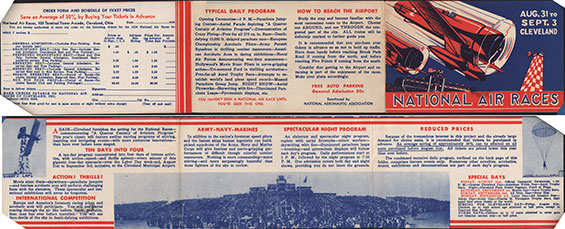 |
That said, of interest in the pamphlet is the list of admission prices at top left. In 1934 you had choices. If you wanted to enter the grounds and wander around without a seat, it cost you fifty cents. At the other extreme, if you wanted to rent a box for four people for the entire show, with free parking and "Special Club" privileges, it cost you $96 at the gate ($80 advance sales). This was a hefty price in 1934: a couple of weeks wages for some. It is tempting to imagine what the special club privileges were.
Elsewhere, the pamphlet highlighted the concentration of ten days into four. It described the typical daily program, "Action! Thrills" aerobatic activities and the special military performances. It gave directions on how to get to the airport, and a summary of special days, for example "Marine Day," "All Ohio Day," "Labor Day."
It is worth it to download and examine this pamphlet. It is a time capsule illustrating the excitment of the National Air Races. Coincidentally, the final day of the 1934 events entertained 60,000 paying customers. This was the highest attendance since 1929. News photographs in articles on PDF pages 24, 26, 34 & 38 illustrate the magnitude of the crowds.
One significant outage in the 1934 NAR was the absence of female pilots and events. There was no women's derby, and no pylon races for women. Two news articles on PDF page 32 lament the missing talent. Women did attend, but they did not compete. A female pilot from Germany (PDF page 36) even stated, "...women were emotionally unsuited for speed races, and that their job in the air industry in the future would be to aid in placing it on a firmer business basis."
This was the year that Register pilot Roscoe Turner won the Bendix Race (PDF page 37); pilot Doug Davis lost his life (PDF page 49) in the Thompson Trophy Race and an Army pilot was lost in Lake Erie (PDF page 25). Despite these last two incidents, below from PDF page 51, Clover Field Register pilot Hiram Bingham declared the 1934 NAR the, "best air meet ever." Choureé highlighted in red pencil the Navy's contributions, as well as his announcing.
Hiram Bingham, 1934 NAR, Ca. September 3, 1934
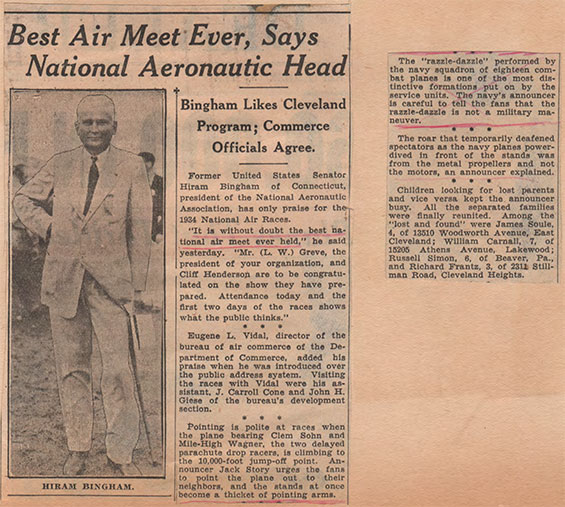 |
After all of the above, if you just have to have more photographs and information about these classic air races, the Michael Schwartz Library at Cleveland State University operates the Cleveland Memory Project. Many photographs of the National Air Races held at Cleveland are at the link.
BACK TO TOP
BACK TO THE COLLECTION
---o0o---
THIS PAGE UPLOADED: 06/16/15 REVISED:
|

